Genre: Platformer Developer: Capcom Publisher: Capcom Players: 1 Released: 1994
Ah, Mega Man. An icon of gaming if there ever was one. You gave me reason to have an NES, and you justified my choice of system back in the 80’s. But along came the Genesis, and into my hands came a shiny new toy with which to play.
Too bad Mega Man didn’t come along for the ride. At least not for a while.
In 1994, Genesis owners who had subscribed to the Sega Channel were given a treat: Mega Man: The Wily Wars had arrived on the Sega Channel, and now the Genesis camp could get to play Mega Man’s first three NES adventures, complete with updated 16-bit graphics and sound. But the unfortunate part of the deal was that we in the U.S. would never see it come in cartridge format, while Japan and Europe both got the compilation. At least we’ve got ROMs nowadays, so U.S. owners can get to play MMWW all over again.
So what is Mega Man: The Wily Wars all about, then? Well, as I mentioned, MMWW is a compilation of the first three Mega Man games released for the NES, presented Super Mario All-Stars style. Also included is a fourth game, The Wily Tower, which is opened by beating the main games. It’s simply one huge fortress, broken down into four main hubs in traditional Wily Fortress-style. Three new robots appear in the tower as bosses: monkey-like BusterRod.G, amphibious MegaWater.S, and huge, hulking HyperStorm.H, and as always, Dr. Wily is waiting for you in the final station of the tower. When you play Wily Tower, you also have the opportunity to take up to six weapons for any of the Robot Masters you’ve beaten in MM1 through MM3 with you, making for some interesting combinations of weapons. Too bad you can’t do that during the main games, though…I would’ve loved to have seen how Wood Man would stand up to Fire Man’s Fire Storm or stop Shadow Man in his tracks with Flash Man’s Time Stopper!
The main games themselves are pretty much as accurate as you can get compared to their NES counterparts, except that all of the graphics and sounds are completely done over and given a 16-bit overhaul. Mega Man and his foes have been given much more detail and are now a fair bit taller, and their animation has improved ever so slightly. But what were given major improvement in this game were the backgrounds. Given the limitations of the NES, everything looked good but kind of plain. Not anymore! The power of the Genesis let Capcom redo all of the backgrounds as well, giving each stage much more intricate detail. Now Cut Man’s stage looks like its taking place on the outside of a giant tower; Shadow Man’s stage looks even eerier; and Wood Man’s stage really looks like a deep forest, just to name a few. One problem I did have was that Rush looks rather stupid in MM3, and when you open the menu there to select him, he’s BLUE instead of RED! Another very stupid oversight to the updated graphics is that when Protoman shows up in MM3, he wasn’t redrawn like Mega Man was; he’s still the same NES sprite with more colors applied to him. Either this was an oversight on Capcom’s part or just plain laziness, but Protoman now looks REALLY funny compared to his brother!
One thing I’ve always loved about the Mega Man games was that the soundtracks always caught my attention, no matter what. MM1 through MM3 had some of the BEST tracks in any Mega Man game to date, so I was really psyched up to hear my favorite tunes being rendered by the Genesis. And where does it all stand? Well…I guess you can say somewhere in the middle. Every single tune from the three games is present and accounted for, so that’s a good start, but the problem was that most of the remixes lack something…don’t get me wrong, it’s nothing about how the tunes are composed or anything! The Genesis audio just doesn’t seem to quite capture the same magic the tunes had on the NES, and I think it’s more due to the fact that Capcom didn’t really make a good effort to use the YM2612 chip in the Genesis to its fullest potential, because with a little extra time, the Genesis could’ve been singing and dancing to the tunes. As it stands, we’ve got three categories where they fall into: awesome: (e.g. Elec Man, Wood Man, Clash Man), okay: (e.g. Heat Man, Needle Man), and “Ugh:” (e.g. MM1 and MM3 boss themes). As for the sound effects, I can’t complain. The sounds are as faithful as you can get to the NES sounds, and at least were spared the mess made with the music.
While the gameplay is pretty much the same as the NES games, there are a few differences I’ve noticed. For one, none of the old cheats from the NES version of MM3 work in the Genesis version, making it even harder than before. That also means that Mega Man vets who used to beat the Yellow Devil in MM1 using the old pause/resume trick (hitting select for the NES paused the game, but also made certain weapons register hits again) can’t on the Genny. Another difference that affects all three games is slowdown. I don’t know how; I don’t know why, but the Genesis versions of these games are even slower in some cases than the NES originals! Case in point: Quick Man and Shadow Man are two of the fastest bosses on the NES, and here they play like someone switched their coffee with decaf! Quick Man used to be so fast for me that I ALWAYS needed to hit him with Time Stopper to beat him, and here I almost never need it. One odd thing is that the slowdown can’t seem to be explained. It can’t be the Genesis CPU; that sucker’s much more powerful than the NES. It seems more like poor programming on Capcom’s part if you ask me.
Although there’s a few flaws that keep this from being an absolute must have, it’s still Mega Man, and Mega Man games are among some of the best and brightest platformer series. So what are you waiting for? Import yourself a copy of the European or Japanese cartridge and help the Blue Bomber save the day!
SCORE: 7 out of 10

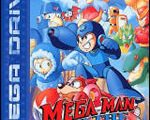
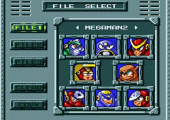
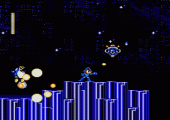
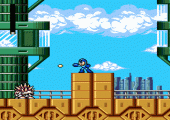
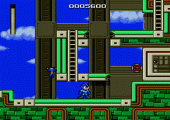
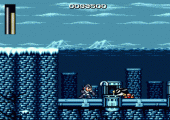
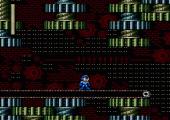
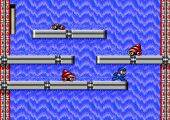
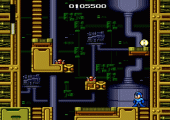
Recent Comments